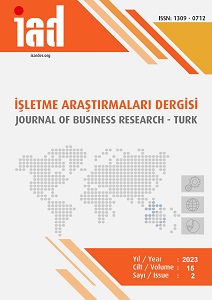Olasılık Dağılımları ve Kolektif Risk Modellemesi Çerçevesinde Portföy Getiri Tahmini: Bist 30 Uygulaması
Portfolio Return Estimation within the Scope of Probability Distributions and Collective Risk Modeling: An Application on the BİST
Author(s): Mahmut Kartal, Ebuzer ArslanSubject(s): Business Economy / Management, International relations/trade
Published by: Orhan Sağçolak
Keywords: Probability Distribution; Collective Risk Modeling; Monte Carlo Simulation Portfolio; Portfolio Return;
Summary/Abstract: Purpose – Examining the distributions and distribution parameters of the shares included in the portfolio for investors, who goals to invest their savings in exchange market by creating a portfolio, the present study goals to statistically estimate the return and risk levels of the portfolios within the scope of collective risk modeling. Design/Methodology/Approach – For this purpose, the daily opening and closing prices of shares, which have been actively traded in the BİST-30 index during the period 2018-2021, were obtained and the distribution parameters and statistical distributions that the data fit were calculated. Using the SWARA and MOORA methods, portfolios were created at three risk levels as low, moderate, and high. Implementing the Monte Carlo simulation method for these portfolios, the average expected return, return probability, and risk levels were estimated. Findings – As a result of the research, during the analyses conducted creating of risk portfolios at different (low, moderate, and high) risk levels, it was determined that the risk level of portfolios was approx. 1% and 2% for all the portfolios. Examining the average return s of the portfolios, it was estimated that the highest daily return would be 2.8‰ and its probability would be 61%. Discussion – Discussion- It has been revealed that the average return and risk level of the portfolios can be calculated more easily with the Monte Carlo Simulation method when the probability distribution parameters are known. These calculations showed similar results with the classical method. In addition, the stocks that are effective on the portfolio return were determined by the simulation method. When the Monte Carlo Simulation method used was compared with the literature, it was determined that similar results were obtained with the quadratic programming (Abay 2013), Finnet Portfolio Advisor program (Zerey and Terzi 2015), Artificial Neural Networks (Yavuz 2012) methods. Compared to other methods, the Monte Carlo Simulation method has been found to be easier and more effective in terms of calculating the results by changing the weights of stocks and the number of assets faster.
Journal: İşletme Araştırmaları Dergisi
- Issue Year: 15/2023
- Issue No: 2
- Page Range: 1461-1484
- Page Count: 24
- Language: Turkish

